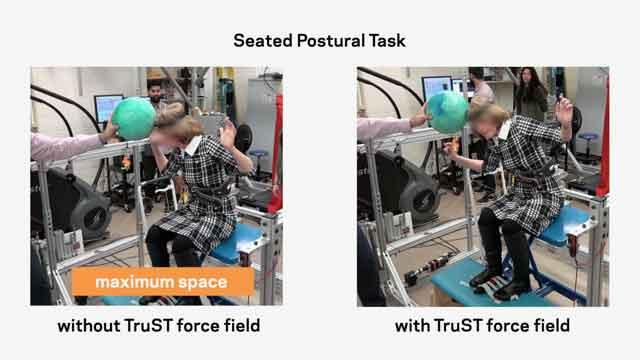Jan 6 2020
Spinal cord injuries (SCI) can lead to traumatic damages such as loss of sensation and mobility. Each year, nearly 17,000 new SCIs are predicted to occur in the United States alone. This rate is higher compared to a majority of the regions across the globe.
 Photos showing an increase in expanded active workspace after a study participant uses TruST, a robotic device invented by Columbia engineers that retrains patients with spinal cord injury to sit more stably. Image Credit: Sunil Agrawal and Victor Santamaria/Columbia Engineering.
Photos showing an increase in expanded active workspace after a study participant uses TruST, a robotic device invented by Columbia engineers that retrains patients with spinal cord injury to sit more stably. Image Credit: Sunil Agrawal and Victor Santamaria/Columbia Engineering.
Moreover, it has been predicted that the SCI rate in people aged 65 years and above, will increase in the United States, from 13.0% in 2010 to 16.1% by 2020. Data also indicates a high survival rate for these patients, struggling to sit down, but still need to function from day-to-day.
A research team from Columbia Engineering has now invented a robotic device known as the Trunk-Support Trainer (TruST). This device can be used to help and train patients affected by SCIs by optimizing their trunk control allowing them to sit more comfortably, thereby achieving an expanded active sitting workspace without the need to use their hands to balance.
The research was recently reported in Spinal Cord Series and Cases and is the first to quantify and define the sitting workspace of patients suffering from SCI based on their active trunk control.
We designed TruST for people with SCIs who are typically wheelchair users. We found that TruST not only prevents patients from falling, but also maximizes trunk movements beyond patients’ postural control, or balance limits.
Sunil Agrawal, Professor of Mechanical Engineering, Columbia Engineering
Agrawal is the principal investigator of the project and also a professor of rehabilitation and regenerative medicine.
TruST, which is a belt driven by motorized cable, is placed on the torso of a user to identify the sitting workspace area and postural control limits in people affected by SCI. When the user carries out upper body movements beyond the postural stability limits while being seated, the device delivers forces onto the torso.
The five subjects affected by SCI who took part in the pilot study were tested with the Postural Star-Sitting Test. This test is a customized postural test, during which the participants are required to follow a ball with their head and move their trunk as far as possible, without using their hands. After repeating this test in eight directions, the researchers used the outcomes to calculate the sitting workspace of each participant.
The researchers then customized the TruST for each participant applying tailored assistive force fields on the torso while the participants carried out the same movements again. Using the TruST device, the participants could reach further as part of the trunk excursions in all eight directions, considerably expanding the sitting workspace around their bodies, nearly 25% more on average.
The capacity of TruST to deliver continuous force-feedback personalized for the user’s postural limits opens new frontiers to implement motor learning-based paradigms to retrain functional sitting in people with SCI. We think TruST is a very promising SCI rehab tool.
Victor Santamaria, Study First Author and Physical Therapist, Columbia Engineering
Santamaria is a postdoctoral researcher in Agrawal’s Robotics and Rehabilitation Laboratory.
Currently, Agrawal and his colleagues are investigating the use of TruST within a training paradigm to enhance the trunk control of children and adults affected by spinal cord injury.
The robotic platform will be used to train participants with SCI by challenging them to move their trunk over a larger workspace, with TruST providing assist-as-needed force fields to safely bring the subjects back to their neutral sitting posture. This force field will be adjusted to the needs of the participants over time as they improve their workspace and posture control.
Sunil Agrawal, Professor of Mechanical Engineering, Columbia Engineering
Robotic Trunk Support Assists Those With Spinal Cord Injury
Video illustrating how the Trunk-Support Trainer (TruST), a robotic device invented by Columbia engineers, retrains patients with spinal cord injury to sit more stably and gain an expanded active sitting workspace. Video Credit: Sunil Agrawal and Victor Santamaria/Columbia Engineering.